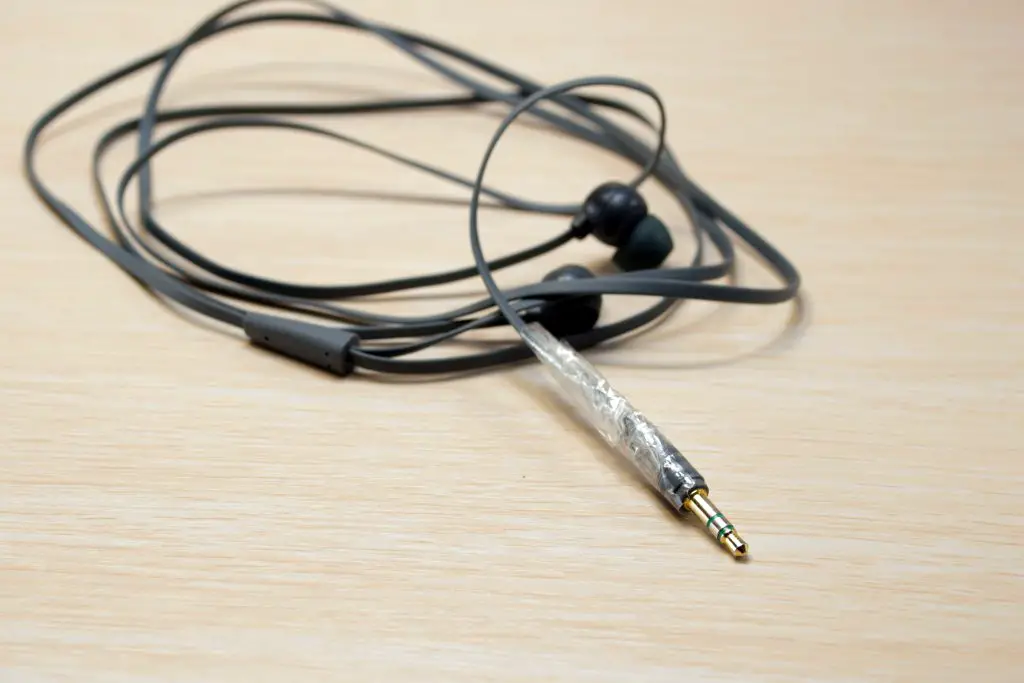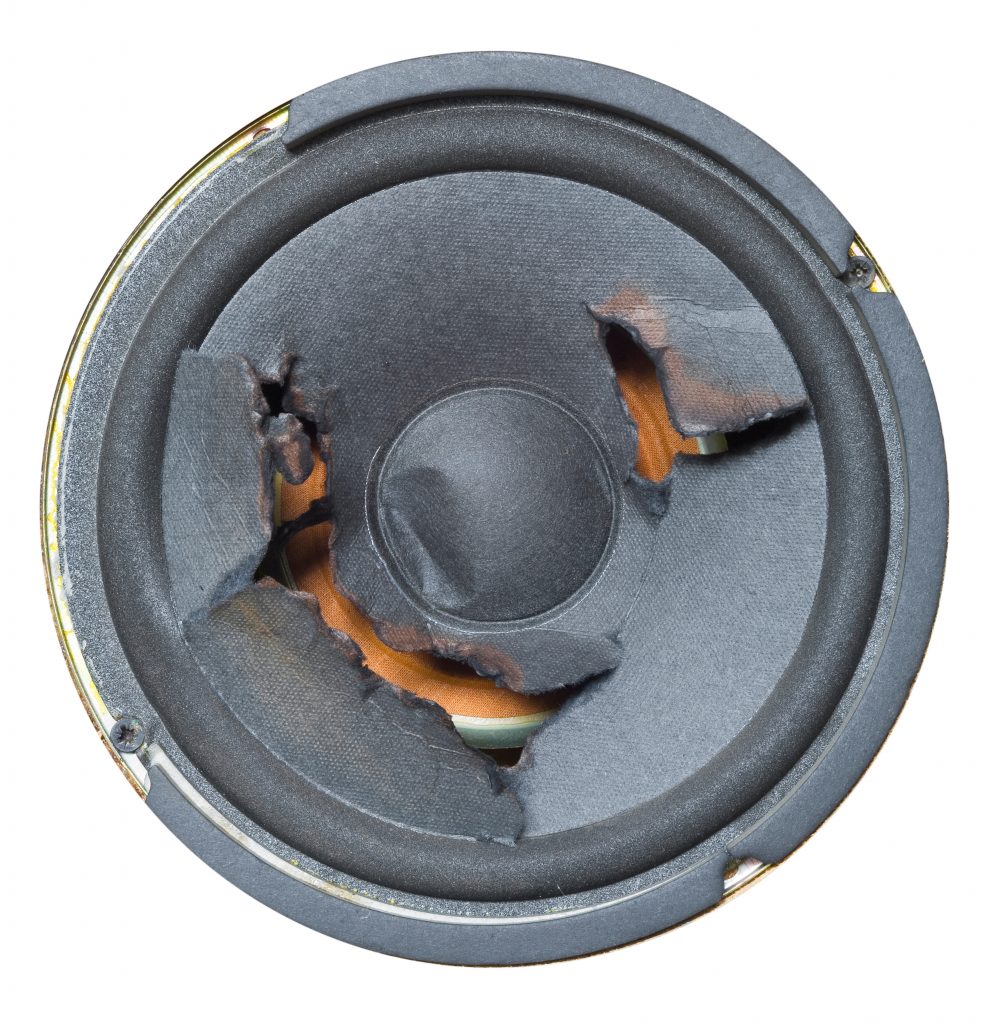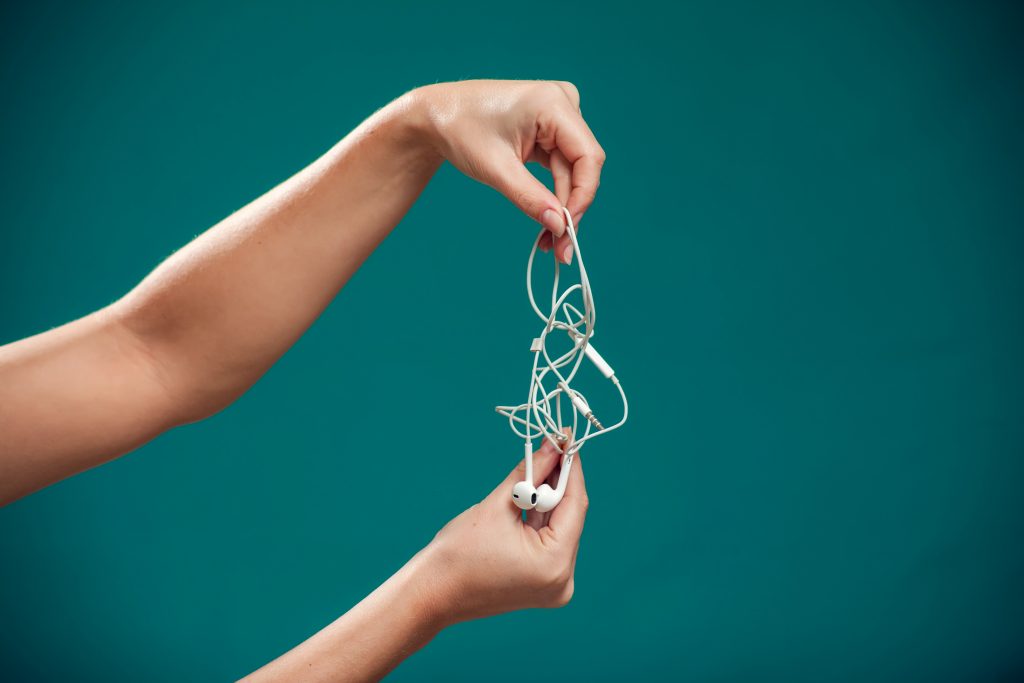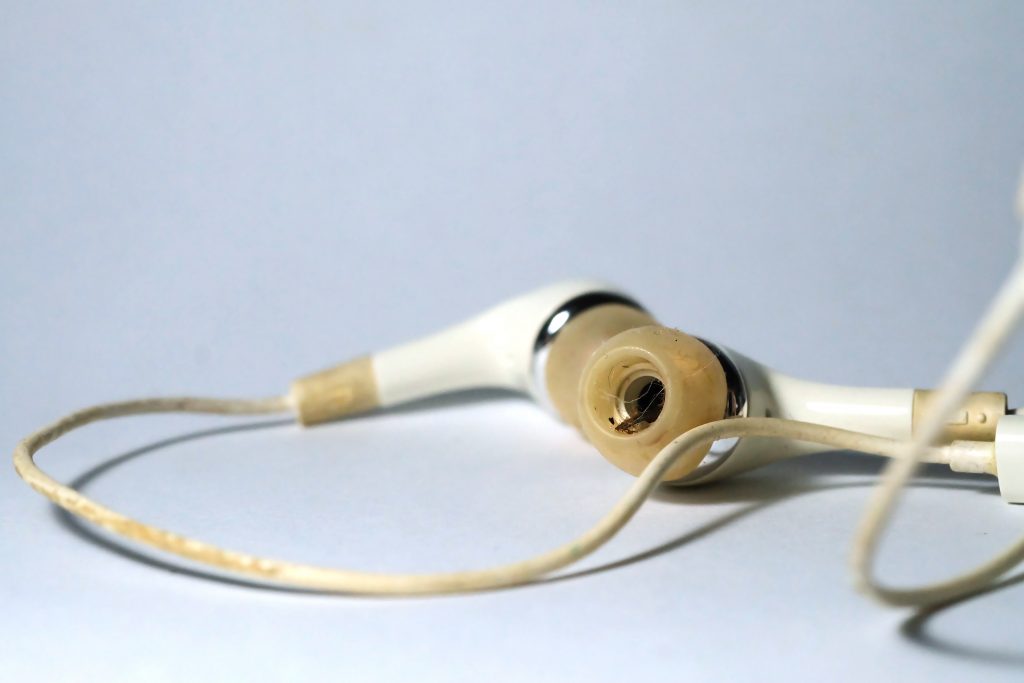There’s nothing more irritating than when your earphones lose their clear perfect quality sound and become fuzzy, muffled, or distorted.
If you’re visiting this page, am I right in assuming it’s happening to your earphones, and you’re wondering why?
If so, you’ve come to the right spot.
In this article, I’ll identify the reasons earphones sound fuzzy or distorted and what you can do to get back to pitch-perfect sound quality.

Contents
Firstly, I think it’s worth knowing a little about distorted sound and how that differs from audio noise. In doing so, you’ll be better placed to take the correct remedial action.
What is distortion?
In the context of this article, distortion is a sign of an audio system problem.
It’s the unexpected sound we hear when there is a change in the original signal or corruption of the source signal.
It’s a change to the sound quality that needs fixing.
What then is audio noise?
Noise is Not Distortion
You can be mistaken for hearing a noise in your audio sound and thinking it is distortion. Not so.
Distortion is caused by a change in the original signal to something different.
Noise does change the sound quality of audio but not by changing the original signal. Instead, an external (random) signal is added to the original signal.
Let me explain by way of an example.
You can turn up the volume on your audio device so loud that the speaker’s sound loses its clarity because it is unable to handle the extra volume. This is distortion.
Usually, noise happens when a power cable runs close to your audio cable or signal. The electrical signals of the power cable interfere with the audio signal, adding what is called noise to the sound, which reduces audio quality.
Now that you understand the difference between distortion and noise let’s look at why it matters.
Distortion versus Noise – Why the Difference Matters
If you’re experiencing sound issues knowing whether it’s distortion or noise will help determine what direction you should take to fix the problem.
If it’s a static type of sound like crackling or hissing, or if it’s occasional different sounds, chances are its noise, and a review of cables and wireless receivers is your likely first action.
If you’re hearing fuzzy, muffled, or otherwise strange and unpleasant sounds through your earphones, it’ll be distortion, and that could mean any number of causes to investigate. These causes range from overloading to different types of faulty equipment.
Let’s now consider these causes in more detail, and what fixes you can take.
Reasons Earphones Sound Fuzzy or Distorted
1. Continuing Excess Power to Speakers Causing Blowout
Audio speakers are designed to handle volume to a specified level. Beyond that level, the speakers will not cope, and the sound becomes distorted. Over time continuing use of the speakers at excess levels will lead to them failing, known as a “blowout.”

You might ask, why does this happen over time rather than the one time your speaker hits max volume?
It’s all about the voice coils in your speakers. Increasing speaker volume in your earphones generates greater power to the speakers, generating a greater amplified (louder) sound. Unfortunately, power in the voice coils causes them to heat, which is ok if only an occasional burst of energy. But many sessions of max volume in your earphones will cause degradation of the voice coil wires and inevitably lead them to overheat and burn through to break the audio signal flow.
That is not what you want to happen because you are probably up for the cost of new earphones.
If you’re a technical whiz, you could try to repair them, but it’s not easy and far too complicated for anyone lacking technological know-how like me.
If you have “blown speakers,” how can you tell. It depends on the extent of the damage to the coils. It could range from hearing nothing to one of a bunch of strange noises like:
- a rubbing sound that causes crackling
- that crackling could happen all the time or only on specific notes or with a particular type of music
- a buzzing sound
- a rattling sound
- a sound that is very thin or very harsh or very bright
As always, prevention is better than any cure, so avoiding blown-out earphone speakers is the way to go. Simply put, it’s – don’t use the maximum volume of your earphones for extended periods.
2. Damaged Earphone Wires Causing Distortion?
If your earphones are wireless and there’s ‘nary a wire in view, you don’t need to read this section for fuzzy or distorted sounding earphones. It doesn’t apply. 🙂
But if you have wired earphones, welcome to “frustration city.”
It’s almost impossible to prevent tangling your earphones. Rolling or squishing them up for storage or untangling them ready for use means the wires are frequently being bent or twisted, or you’re yanking the end of the earphones. Again, over time damage can occur.

The wire inside the rubber or plastic casing is delicate and thin and, with constant usage, can break either entirely or partially. In some cases, a complete break results in no sound at all. But that or a partial break could lead to “shorts” where the sound cuts in or out and the audio sounds fuzzy.
Testing whether your earphone wires are damaged and causing your sound problems requires a systematic approach and a little patience:
- plugin your earphones with music or sound being transmitted
- listen to each earphone separately to determine whether it’s one or both earphones with the problem
- if it’s one earbud with distorted sound, bend the wire at one end and run that bend to the other end of the wire as you listen for any disturbances based on the movement of the wire
- if it’s both earphones, do the same from the plug end to where the cables part for each earphone end
Taking this approach should mean you’ll be able to tell if the wires are causing your audio problems.
If you find that the wires are the reason, you can either repair them or ditch the earphones and buy a new set. As with blown-out speakers, the repair approach requires knowledge, skill, and patience, all of which I don’t have, so you know what I would be doing.
If you want to avoid tangled wires and the consequent scrunching up, bending, twisting, and yanking of the cord at either the plug or earphone ends, it will be worth your while investing in an earbud case. It means you can wrap the cord in an orderly circular fashion without bending the wires at a sharp angle and leaving them protected in the case while carrying them around in your pocket or handbag.
3. Not the Earphone Wires But a Dirty Earphone Jack?
In the case of wired earphones, it could be that it’s not the wires but a dirty headphone jack causing the fuzzy or distorted sound.

With constant use over time, your earphone jack will get dirty with dust, lint, or other barely visible substances on its surface. These substances will create a barrier between the jack and audio port surfaces. If it gets dirty enough, the connection between the jack and the port will be adversely affected and cause interference to the audio signal. When that happens, the sound becomes fuzzy and distorted.
The remedy for this problem is simple. You need to clean the jack and the port back to an “as new” condition. There are several ways to do this:
A. Compressed Air
A pressurized can of air can be used for both the jack and the port. Releasing concentrated pressurized air through the tiny thin tubes attached to the mouth of the can blow away most dust and lint when you hold the can close to the jack or into the port.
B. Cotton Swab
If you’re cleaning the audio port, you may need to remove some cotton from the stick to fit into the port. Either way, spray a little alcohol on the swab. Next, rub the swab all around the jack or deep into the port to clean both the sides and bottom. This has the advantage of cleaning any dust or lint that remains adhered to the surface of the jack or port.
C. Paper Clips
A paper clip is another method you can use for the audio port if you don’t have a cotton swab. It’s not likely you’ll need to use this method for the jack. While it is both thin and doesn’t have a sharp end, I don’t recommend you use it being metal on metal. You could damage the surface of the port. If you can, wrap sticky tape around the clip (sticky side out) and insert it into the port, moving it around for loose debris to stick to the tape.
Hopefully, your distortion problems have disappeared due to your cleaning activities. If not, it could be that the earphone jack or even the audio port is internally or externally damaged somehow. But before you leap to that conclusion, you should continue your investigation to rule out the remaining reasons for earphones sounding fuzzy or distorted.
4. Sub-Par BlueTooth Connection (Wireless)

If your earphones are wireless and use Bluetooth to connect to your audio device, there could be several reasons why you’re hearing fuzzy or distorted sounds:
A. Lack of Compatability
If you’ve had problems from the very first time you connected, it could be that your device is not compatible with your earphones. Your audio source and earphones use a codec to communicate with each other. Unfortunately, both may use a subpar codec below your earphones’ capability, causing lower sound quality transmission.
Unfortunately, your only possible solution is to either change your audio device or your earphones to ensure they are fully compatible with each other.
B. Insufficient Battery Charge
If distortion starts to happen and becomes gradually worse, it could be that one or both of your devices are running low on the battery charge, and it’s time to replace or recharge your batteries—a simple fix.
C. Too Many Wireless Signals
Have you turned your home into wireless heaven with Bluetooth or Wi-Fi connecting all your electronic gadgets? Usually, this shouldn’t be a problem because most of the signals from these gadgets are designed to work together. Sometimes, though, they can interfere, causing Bluetooth audio to stutter.
If this happens, you can become a detective by turning off your wireless devices one by one until you find the culprit disrupting your earphone’s signal. Alternatively, you could move away to another room or area with reduced wireless activity, and your earphones return to the usual audio quality.
D. When in Doubt, Reset
I should probably have listed this reason first. Sometimes electronic devices get out of whack. I’m sure there’s been at least one time when you’ve rung a technical support line for help with a computer problem. Almost without fail, their first instruction is, “have you rebooted your computer?” Your fix to a distortion problem with your earphones may be as simple as powering down and powering up again and repairing your devices.
So much for connection problems with Bluetooth earbuds. Now I’ll turn to the following reason for a distorted sound that can happen to both wired and wireless earphones.
5. Can it be Moisture Damage Causing the Fuzzy or Distorted Sound?
Water and electronics are not a mix that works. Any water or heavy moisture can damage an electronic device, and earphones are not excluded from that possibility. But you say, what about earphones that are described as water-resistant? Now here’s the rub. Being water-resistant is not the same as being waterproof. Let me explain.
There’s an international rating system called the IP (Ingress Protection) rating system, which is a system that applies ratings to a device’s ability to withstand damage from solids and water. It is usually expressed as “IPXX,” where the first X can be a number from 0 to 6 that identifies the degree of protection from solids. The number range for the second X is from 0 to 9 and applies to water protection. The highest number in each case represents the most significant degree of protection.
If your earphones are rated as IP67 or IP68, testing will find them dustproof and mudproof (hence the number 6). And waterproof (therefore the number 7 or 8). Any device with a water protection rating of 7 has been tested by submersion underwater up to 1 meter for at least 30 minutes. The 8 rating applies to extended immersion at a greater depth.
Unfortunately, most earphones have not earned that rating and mainly carry a water protection rating between 0 and 4 (some don’t even have a rating). These rated earphones are likely to suffer damage from exposure to moisture or water like a light shower of rain, sweating from exercise, or steam in a sauna. If water damage occurs, you are more likely to hear nothing in your earphones than a fuzzy or distorted sound.
Your best bet in protecting your earphones from moisture damage is to only use them in situations that match their IP rating. While the sound of music may be incredible with your IPX4 earphones, it’ll pay not to wear them if it’s likely to rain during your walk or run.
Now let’s take a look at what can affect the audio quality of your earphones merely from daily use.
6. What About Debris from Daily Usage of Your Earphones?
Like your headphone jack and the port on your audio source, the earphone plug ends themselves can accumulate not only dust and lint but also earwax.

If your earphones have a solids rating of 6, there won’t be any problem with the debris accumulating internally. But being tucked into the ear canal the likes of earwax can stick to the outer surface and block or limit the sound.
Earphones with lower ratings could experience an internal build-up of lint and dust, affecting the sound quality.
No matter the rating of your earphones, it pays to keep them clean. I’ve found that alcohol wipes from your local pharmacy are best for this purpose. Ideally, you should use the wipes after each use before storing them. This will help avoid debris build-up and even remove bacteria from the earphones.
If it feels like I’ve exhausted all possible reasons for your fuzzy or distorted sounding earphones, you’re right. So what if the problem is not your earphones?
7. Is It Your Audio Source and Not Your Earphones?
Maybe, just maybe, your earphones are not the problem. But, on the other hand, perhaps the problem all along has been your audio source, i.e., what’s transmitting your music. A quick test of your earphones with another audio source like your laptop should rule out (or rule in) that possibility.

Summary of Reasons Earphones Sound Fuzzy or Distorted
I hope you have found this article helpful in identifying why earphones sound fuzzy or distorted.
Ideally, you learned the difference between noise and distortion and how that helps direct your efforts to find the reasons for your sound problems.
And that I’ve explained each reason in enough detail to help identify the cause and the possible fixes.
